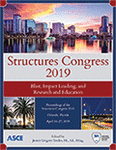Structures Congress 2019
Behavior of Fiber Reinforced Cementitious Matrix Elements under Combined Thermo-Mechanical Loads
Publication: Structures Congress 2019: Blast, Impact Loading, and Research and Education
ABSTRACT
Typical strengthening of concrete structures is currently achieved with fibre reinforced polymers (FRP), which uses organic resin (epoxy) in the process of application. But towards the end of the last century, an upgraded system was introduced as an alternative for FRP for the rehabilitation of historic and damaged concrete and masonry structures known as fibre reinforced cementitious matrices (FRCM). FRCM systems are made from different materials like glass, steel, and carbon fibre meshes that each has a different strengthening capacity and temperature resistivity. The mesh of this system is formed from fabric grids and cementitious matrix components that are functioning as a matrix and binder. The inorganic cementitious mortar used by FRCM systems can be advantageous in harsh environments due to its excellent thermal behaviour and binding characteristics. Several small and large size beams were initially strengthened with FRCM systems and tested mechanically under four point bending. One and two layers of FRCM, as well as steel net material were used, and compared with a control beam. The observed results confirmed the higher flexural capacity and stronger bond when FRCM system replaces FRP composites in strengthening of concrete beams. In addition, several concrete specimens reinforced with FRCM and steel net were tested under a combination of mechanical loads representing gravity and controlled elevated temperatures. The results confirmed the specimens strengthened with FRCM outperformed those using typical FRP composites, mainly because of the superior thermal performance of the cementitious inorganic resin. Further, a new numerical finite element model was developed to investigate the structural response of FRCM-strengthened specimens under thermo-mechanical loads. The model was validated against the derived experimental data. The model was then used to investigating the different parameters affecting the behaviour of FRCM systems, especially at higher temperatures. The study demonstrates the viability of using FRCM systems as the strengthening and replacement material for FRP composites, particularly under elevated temperatures.
Get full access to this article
View all available purchase options and get full access to this chapter.
ACKNOWLEDGEMENT
G and P Intech Company in Italy, has provided all the necessary strengthening materials used in this study free of charge; for that the authors would like to thank them.
REFERENCES
Al-Salloum, Y. A., Elsanadedy, H. M., Alsayed, S. H. and Iqbal, R. A. (2012). Experimental and numerical study for the shear strengthening of reinforced concrete beams using textile-reinforced mortar. J Compos Constr. 16:(1)74–90.
Bisby, L. A., Stratford, T. J., Roy, E. C. and Ward, M. (2009). 'Fibre Reinforced Cementitious Matrix Systems for Fire- Safe Flexural Strengthening of Concrete: Pilot Testing at Ambient Temperatures'. In Advanced Composites in Construction (ACIC) 2009 Conference Proceedings. Net Composites Ltd., pp. 449-460.
BS EN 12390-3:2009. Testing hardened concrete, Part 3: Compressive strength of test specimens. Compression testing machine, conforming to EN 12390-4.
Ehlig, D., Jesse, F. and Curbach, M. (2010). “Textile reinforced concrete strengthened slabs under fire loading.” Beton- und Stahlbetonbau, 105(2), 102–110.
Kolsch, H. (1998a). Carbon Fibre Cement Matrix CFCM overlay system for masonry strengthening. J Compos Constr. 2: (2)105-109.
Kolsch, H. (1998b). Eine Laminatbeschichtung aus Kohlenstoffgeweben und Zementmatrix zur Mauerwerksverstarkung. Bauen mit Textilien Heft 2: 13-18.
Loreto, G., Leardini, L., Arboleda, D. and Nanni, A. (2013). Performance of RC slab-type elements strengthened with fabric-reinforced cementitious- matrix (FRCM) composites. J Compos Constr. 18, (3)pp.1090–0268.
Loreto, G., Babaeidarabad, S., Leardini, L. and Nanni, A. (2015). RC beams shear-strengthened with fabric-reinforced-cementitious-matrix (FRCM) composite. International Journal of Advanced Structural Engineering (IJASE), 7(4), pp.341-352.
Nanni, A. (2012). FRCM strengthening—a new tool in the concrete and masonry repair toolbox. Concrete Intern Des Constr. 34(4), pp.43–49.
Papanicolaou, C., Triantafillou, T., Papantoniou, I. and Balioukos, C. (2009). Strengthening of two-way reinforced concrete slabs with Textile Reinforced Mortars (TRM). In Proc. of the 4th colloquium on textile reinforced structures (CTRS4) und zur 1. Anwendertagung, SFB 528. Eigenverlag: Technische Universität Dresden. pp. 409–20.
Shilpa, K., Panda, G. and Kumari Mamta, 2010. “damaged and degradation study of FRP composite”, Report of Department of Metallurgical and Material Engineering, National Institute of Technology, Rourkela.
Triantafillou, T.C. and Papanicolaou, C.G. (2006). Shear strengthening of reinforced concrete members with textile reinforced mortar (TRM). Mater Structure 39:(1)93–103.
Information & Authors
Information
Published In
Structures Congress 2019: Blast, Impact Loading, and Research and Education
Pages: 270 - 278
Editor: James Gregory Soules, McDermott International
ISBN (Online): 978-0-7844-8224-7
Copyright
© 2019 American Society of Civil Engineers.
History
Published online: Apr 22, 2019
Published in print: Apr 22, 2019
Authors
Metrics & Citations
Metrics
Citations
Download citation
If you have the appropriate software installed, you can download article citation data to the citation manager of your choice. Simply select your manager software from the list below and click Download.
